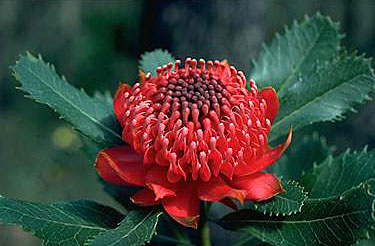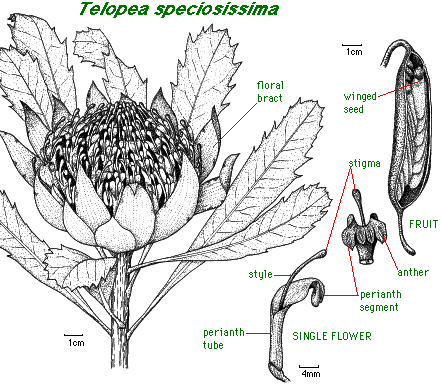Growing Waratahs
|
Waratahs are spectacular garden plants. These plants are in the genus Telopea which is in the family Proteaceae. They produce bright red flowers in spring (although some plants selected and/or bred in cultivation produce white, pink or yellow flowers) and attract a wide variety of birds. Telopea speciosissima (the New South Wales Waratah) has for a long time been one of Australia's most admired flowers. It is the state floral emblem of New South Wales and is grown in some areas as a commercial crop for cut flowers. |
It is not so well known however that in addition to Telopea speciosissima, there are four other species of Telopea. They are:
Telopea aspera New England Waratah |
Telopea mongaensis Monga Waratah |
Telopea oreades Victorian Waratah |
Telopea truncata Tasmanian Waratah |
Of the five species, Telopea mongaensis has proved to be the most easily established in cultivation. Several Telopea cultivars, some merely colour forms of straight species and some hybrids between T. mongaensis and T. speciosissima are beginning to be available at local nurseries. They include:
Telopea 'Braidwood Brilliant' |
Telopea 'Coroboree' |
Telopea 'Erinundra White' |
Telopea 'Sunburst' |
Telopea 'Wirrimbirra White' |
|
|
The Telopea 'flower' is in fact a conflorescence that comprises, depending upon the species concerned, from as few as 10 to as many as 240 individual flowers.
|
|
Propagation of Telopea species
Telopea can be grown from cuttings but the more usual way is from seed
(although selected varieties and cultivars must be propagated from cuttings
if they are to remain true to form). Fresh seed has a high viability and germinates
in 2-3 weeks after sowing. Plants should be potted up as soon as they are large
enough to handle and grown in a sheltered position.
When selecting a plant for planting into the garden ensure that it is at least
15 cms tall. Plants of this size should have a noticeable swelling at the base
of the stem where it enters the soil. This 'swollen' tissue is a lignotuber
and it contains numerous dormant buds. When established in the ground old canes
can be cut right back to the lignotuber which will promptly sprout new stems.
This is an evolutionary adaptation to some of the extremes of the Telopea environment (particularly bushfire) which ensures the plant's survival.
Cultivation of Telopea species
Telopea generally appreciate a friable soil of good texture. The incorporation
of a rich leaf compost or similar material is beneficial. If other soil is add
to the site, always incorporate it into the existing soil. Do not excavate a
large hole and then fill it with a good soil mix, as water will accumulate in
the hole resulting in wet feet and probable plant death.
Good drainage and aeration are essential, and if possible should extend to a
depth of 45 cm. Drainage can be improved by building a raised bed or mound.
If this is done, be sure to break the existing soil where the mound is to be
located so that the new soil can be incorporated with the existing soil.
Watering can be carried out during hot or dry spells. Never let the soil dry
out completely. Over-watering in heavy soils will cause waterlogging.
Telopea appear to be adaptable to various situations but a semi-shaded
position or at least shade from afternoon sun is desirable.
Mulch the surrounding soil to a depth of 5-6 CMS This will help to keep the
soil moist and keep the surface roots cool. Mulch also helps to prevent weed
growth in the vicinity of the plant. If weeds are allowed to grow they provide
direct competition to the plant for nutrients and water. Removal of weeds may
also disturb the surface roots and result in setback of the plant.
Plant the Telopea in such a place that it is able to receive plenty of
air circulation and room in which to grow.
Flowers can be cut for indoor decoration or can be removed from the plant after
flowering has finished by cutting the canes back to at least half of their length.
Do not let seed set unless it is wanted as their formation saps a lot of strength
from the plant.
Telopea respond well to applications of a slow-release nitrogenous fertilizer
such as blood-and-bone or a slow release general purpose fertilizer with a relatively
low phosphorus content applied at 100 gm/sq.m. once each year in Spring.
Further reading:
Dawson, I. Telopea 'Braidwood Brilliant'. http://www.anbg.gov.au/telopea-braidwood-brilliant/telopea-braidwood-brilliant.html. Australian National Botanic Gardens website, Canberra, Australia.
Evans, P. & Johnson, K. (1998). Phosphorus sensitivity in some Australian species. Australian Hortiulture. Vol. 96 (11): 28.
Nixon, P. (1997). The Waratah. 2nd edition. Kangaroo Press, East Roseville, Sydney, Australia.
Wrigley, J.W. & Fagg, M. (1989). Banksias, Waratahs and Grevilleas and all other plants in the Australian Proteaceae family. William Collins Publishers, Sydney, Australia.
![An Australian Government Initiative [logo]](/images/austgovt_brown_90px.gif)


















